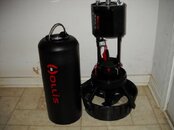I got a used Hollis H160 a while ago at a good price, so good that I did not do a lot of research on it. I am now trying to figure out how to make that "good deal" work out for me.
The problem I am trying to solve is one of buoyancy and trim. With no weights in it, it is still negative in fresh water. I would like it to be at least neutrally buoyant, if not a tiny bit positive in fresh water. With no weights in it, it is very nose light--it sinks to the bottom with the nose pointed up. If I put a single weight in, it is nose heavy, and it is, of course, even more negative than before.
I got a suggestion to glue strips of 7mm neoprene to the cowling.
Any other ideas?
The problem I am trying to solve is one of buoyancy and trim. With no weights in it, it is still negative in fresh water. I would like it to be at least neutrally buoyant, if not a tiny bit positive in fresh water. With no weights in it, it is very nose light--it sinks to the bottom with the nose pointed up. If I put a single weight in, it is nose heavy, and it is, of course, even more negative than before.
I got a suggestion to glue strips of 7mm neoprene to the cowling.
Any other ideas?





